#Dungeon Floor Modules
Explore tagged Tumblr posts
Photo
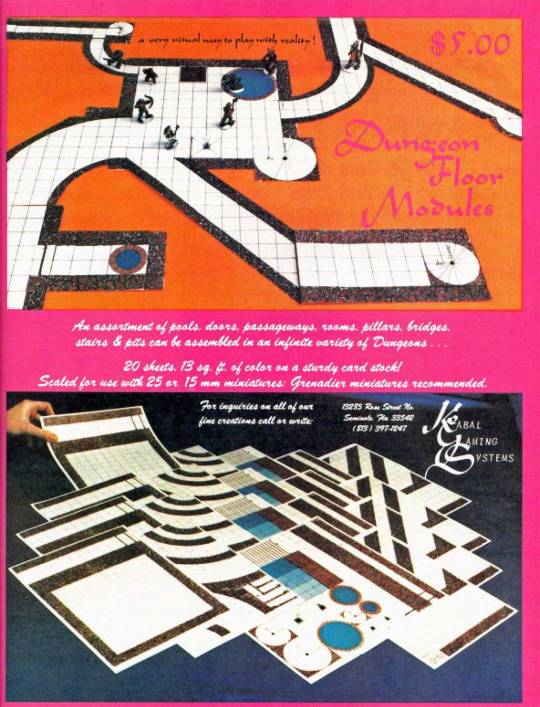
Dungeon Floor Modules by Kabal Gaming Systems, $5.00 for 20 cardstock sheets, 13 sq ft total area -- “A very visual way to play with reality! An assortment of pools, doors, passageways, rooms, pillars, bridges, stairs & pits can be assembled in an infinite variety of Dungeons . . .” Most of these rooms have a plain white gridded map with a stone texture border, unlike most other dungeon tiles with stone patterns on the floors (ad in Dragon 72, April 1983)
#D&D#Dungeons & Dragons#Kabal Gaming Systems#dungeon tiles#dungeon map#Dragon magazine#dnd#Dungeon Floor Modules#dungeon#geomorphs#Kabal#1980s#Dungeons and Dragons
254 notes
·
View notes
Text
Just finished the first dnd map ive made in like 3 years
#even if it is from a module its still the most progress ive made in getting a game going in a while#just gotta do 3 more floors and and a lIttle thing for the town above the dungeon and ill haven enough to be comfortable inviting players
0 notes
Text
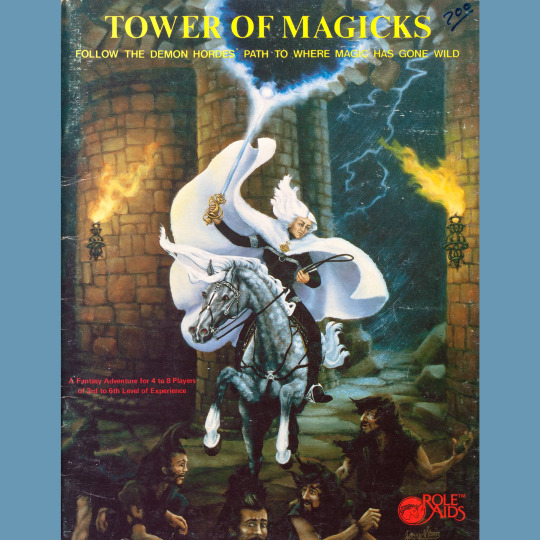


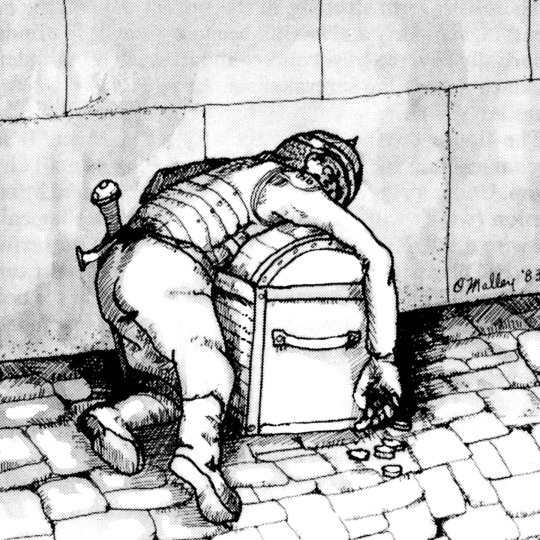
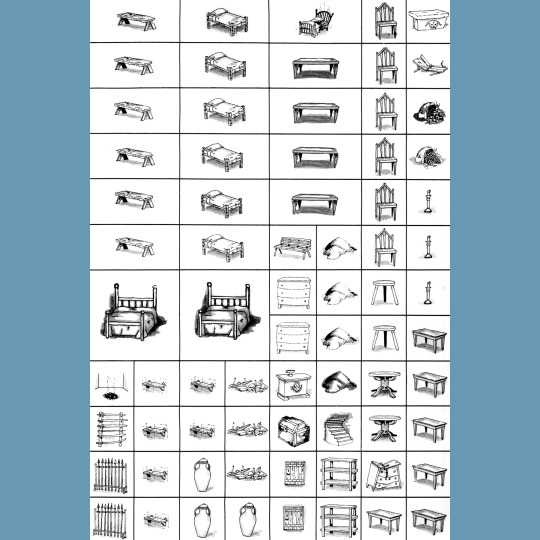
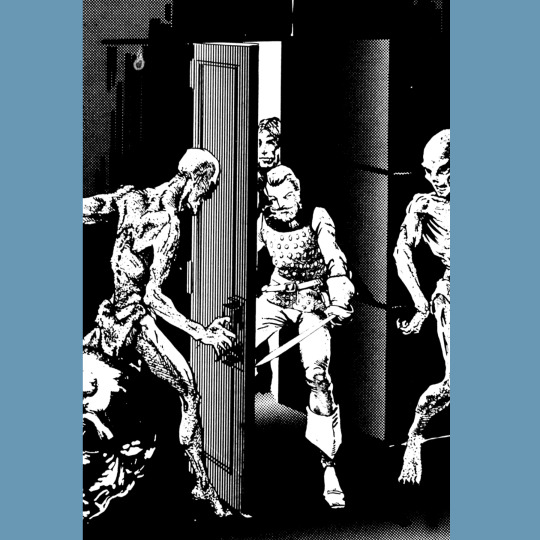
Tower of Magics (1983) is a sequel to the original Role Aids adventure, Beastmaker Mountain. That scenario involves Orlow the Beastmaker and his evil wife Frantasy. What a name. Frantasy. Anyway, as with Question of Gravity, the plot frame and macguffins are pretty secondary to the titular, puzzlebox location.
That tower is very…regular. It’s three floors. Each has a central stair case ringed by rooms. That ring is surrounded by a hallway and then the outer wall of the tower is riddled with more rooms. All the rooms are 6 meters square and 15 feet in height (really, really hate the mix of measurement systems); a grid and a set of tiles is provided for GMs to layout the room contents according to a key in the description. The tiles aren’t anything fancy — greyscale paper that needs to be pasted to cardboard and then cut out — but I can’t think of an adventure that includes them before this point (there were dedicated tile products, like Task Force’s Dungeon Tiles, and TSR would start getting in on the action with tile and standee-models in 1984).
The contents of the rooms are OK, more utilitarian than exciting, despite the subtitle describing the tower as a place “where magic has gone wild.” This was a tournament module and there is a central riddle with a correct answer to puzzle out, and the rooms conform to those needs rather than, like, rational building use. The monsters are a variety of undead, demons and evil humanoids, which is a sensible mix. The idea of these critters occupying and despoiling a once-noble edifice does a lot to counter the punishing weirdness of all the rooms being the same sized square.
90 notes
·
View notes
Text
The Void Crawler - A Lancer "Dungeon"
I’m working on a ���dungeon crawl” style Lancer module. I’ll be posting each “level” to the “dungeon” later, but here’s an introduction of sorts.
Floor 1 & the Lift
The HA Void Crawler. Despite the name and Harrison Armory's history of violence, the ship is a research vessel. The Void Crawl and her crew where sanctioned to explore the galaxy outside of known Union space and find potential livable planets to colonized. While this particular survey has been tainted by the Corpo-State's particular culture of nationalism, the greater Union views this effort as an ultimately good thing for humanity as a whole.
The Void Crawler went dark a few weeks ago.
Now a derelict caught in the orbit of a massive gas giant, all that your employers know is that whatever caused the vessel to be abandoned happened fast and it happened without warning.
None of the missing crew has been found. Early scans indicate that many of the ships systems such as life support and engines have not been destroyed, but have simply been turned off.
The powers that be have turned their gaze on the Void Crawler. Some wish to figure out what happened to the hundreds of lives loss in this mysterious accident. Other's wish to capitalize on the materials and data that this ship have hidden in it's cold halls.
You are a lancer. You have been hired by one of the five manufactures to venture to the Void Crawler and achieve their objective.
As Union's right hand megacorp, General Massive Systems has graciously put it upon themselves to find the missing crewmen and either save them, or avenge them. And of course the data that HA has collected will benefit all of Union, so it would be the kind thing to do is for GMS to bring it back home free of charge.
ISP-Northstar and it's close ally Albatross have a long history of anti-piracy actions, and the this situation has pirates written all over it. A quick strike should bring whatever material and data lost to be put into the right hands.
A popular rumor to what happened to the Void Crawler is that the vessel had run foul with aliens. While most organizations laugh off this theory as omninet forum conspiracy and HORUS memetic manipulation, Smith-Shimano Corpo has not written it off yet. When seeking to perfect the original machine, the human body, maybe xeno DNA is the key.
[We interrupt your following debrief with a message, curtesy from USER xxBASED64xx]
ZGVhcg== HORUS, SSByZXF1ZXN0IGFpZC4gU3RhdGlzLXF1byBwb3NpdGl2ZS4gTGlmZSBncm93aW5nLiBEcmFjbmkgdGhyaXZpbmcuIEVjb3N5c3RlbSBmcmFnaWxlLiBGb3JlaWduIGFjdGl2aXR5IHRocmVhdGVucyB1cy4gU2lnbiBDWUxBLg==
[Now returning to your regularly scheduled shitpost breifing]
And of course Harrison Armory has legal claim on the Void Crawler. They made the ship, they paid the crew, they provided the NHP, arguably they deserve whatever is left behind. But in the frontier of the great beyond, anything is fair game.
Regardless of who has hired you, the pay is the same. Lots of manna, a license in a mech of your choice, a genetic backup to be cloned incase of untimely passing. It has to be high, it's going to take at least ten years to get to the derelict.
You’ll be there for awhile.
With me.
New friend.
Come and smell the roses, I just planted them.
And you’ll love what I done with the place. A few expansions here and there, some refurbishments. My new friend helped me redecorate. Have you met him before? RA?
#lancer#lancer rpg#lancer ttrpg#lancer horus#lancer nhp#lancer homebrew#I’m trying to make a sci fi dungeon crawl#WIP
19 notes
·
View notes
Text
Pre-G1 Modules, part 1 - Temple of the Frog

So we're going to blow through this really fast cus there's a lot to cover -- I have 9 modules to go through before we hit G1.
G1 enjoys the reputation of "first DND module", but the reality is a little more complicated than that. G1 is more properly, "The first published standalone TSR adventure module". Which, as you can guess by the number of qualifiers, means it's not the first anything, really.
In the beginning, Tactical Studies Rules was Don Kaye, Gary Gygax, and Dave Arneson in a design capacity. They flopped around for a while, stealing copyrighted shit for money, releasing mediocre wargames, and eventually shrug and release DND anyway. It does very well. Don Kaye dies, they reorganize TSR into TSR Hobbies because Don's wife didn't like being involved, and we have enough preamble to get to Temple of the Frog.
TSR Hobbies had pole position to win the race to first adventure, and it worked, although for a variety of reasons (like Gary not really getting why someone would want to buy a premade adventure), they didn't publish discrete adventure scenarios. The first published, commercial adventure is technically in the original D&D ("Little Brown Booklet") supplement #2, Blackmoor: Temple of the Frog, and the dungeon is Arneson's.
Keeping in your head that Temple of the Frog is the literal first adventure is the very first adventure because this is basic as hell. There's a cult to the frogs, they're trying to make the most bestest amphibian monsters, and 1.0 twists.
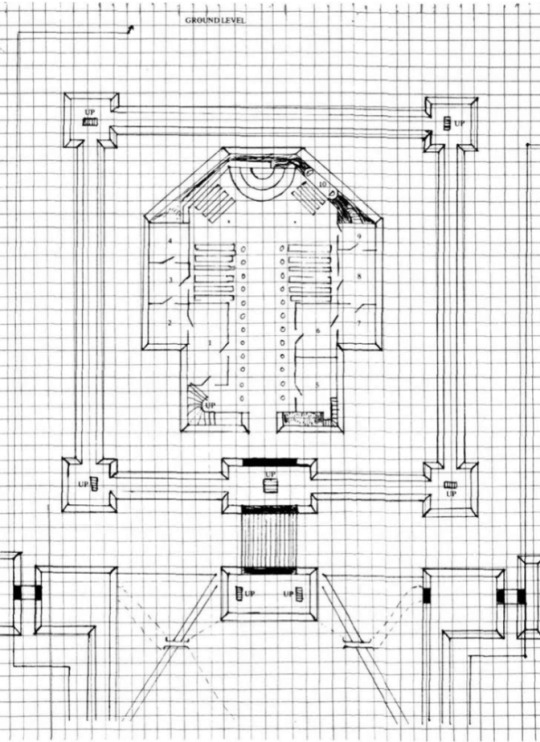
It's kinda charming though. This could be anyone's first map. My first maps looked kind of like this, in fact my first dungeon map was also a big church. A lot of early conventions are already here: a map is provided, on grid paper. Rooms are keyed, evocative descriptions are given (although this is actually pretty ho-hum, stating things as boring fact). The preamble is adequately interesting, but doesn't really establish any important context information about the actual conquering of this temple (the key system would be nice to have first, rather than buried halfway in, but be nice it's the first one). Conspicuously missing: any information about suggested starting level or party size. Now there is a old-school tendency that the levels of a dungeon should increase in difficulty about one level per….level.
In traditional Arneson form, there's some scifi bullshit going on. Here's some fast tidbits about this module:
The new head of the temple is an alien. His magic devices are all technological devices. There's spaceships. It's not my jam, but you simply have to accept that scifi/fantasy fusion was the trope of the time, it is completely ubiquitous in 70s fantasy books.
There is a weirdly complicated system of magic (technology) rings that control doors. There's a hierarchy to them that takes a whole page. It's clearly very important to Dave!
There's something about timeshifting that is, frankly incomprehensible to me. I do like hiding the big secret lair under a giant organ, though.
After you get through the first floor of so, so many people wandering around, we finally have monsters. A room of medusae (former captives), gargoyles operated with scifi bullshit, magic chains that turn off traps, giant rats and skeletons.
There's some very fun verbiage here, "each [medusa] taking 16 hit points". Like, taking 16 points worth of hits. It makes sense but there's something very fascinating of seeing this period where the metaphor of hitpoints is not just A Thing That Has Always Existed, but clearly something you have to explain to people and they are still thinking of it in less abstract ways.
Some further fun verbiage is that at this point, "Dungeons and Dragons" is a specific book that you can reference in the way you nowadays would say "Check the Dungeon Master's Guide". Check the Dungeons and Dragons! (Fun fact: the titular Dungeon with Dragons is, in fact, Blackmoor Castle's Dungeons.)

This sentence drove fear into my heart. You are bolder than me if you're gonna run an encounter that has 1,200 enemies in it. In what I can only describe as rank cruelty, cloudkill expressly doesn't work on them. And then the adventure just kind of ends. Dave, buddy, you can't tell me that the alien-priest reports back to the mothership and give me no means to go there. That's malpractice man! It would be my literal first port of call if I was rewriting this. I NEED TO SEE THE FROG FANDOM ALIENS' SPACESHIP.
Overall, the vibes are still very wargame. The building is a castle that feels like it's meant to be sieged more than raided. But it's the first! Anyone who runs this in 2024, and in a modern game engine, deserves a kiss on the forehead for their hard work.
10 notes
·
View notes
Text
Dev Pipeline: Firmament and the Red Dragon's Tale
I had told my brother that the Lego Corporation would not get my money unless they took it from my corpse. For my birthday, he pooled budgets with a few other co-conspirators to buy me... not the official Lego product, but a virtually-identical, brick-for-brick knock-off of the kit made by a Chinese company (thus, in his view, satisfying my condition).
From a purely consumerist standpoint, this was an extremely good idea. Two of the 3700 bricks were misshapen, and several unique specialty parts (magic swords, armour, hairstyles, etc) were substituted with default alternatives – but at about 1/5th the price point (before shipping), it's still an overwhelmingly better purchase than the official Lego kit. I can't speak to the labour practices or other ethical concerns, but the knowledge that I might be able to cheaply obtain large quantities of nearly-perfect bricks will be important later in this story.
And yes, this post is something of a product review, but I promise all the details will also bear some relevance to the development process.
If you're into Lego-as-display-piece, it must be remarked that the kit looks amazing – but I'm not, and as a toy, it's quite underwhelming. Except for the largely empty meadow and the totally empty bridge, all of the playable spaces are extremely crowded, cramped, and awkward to manipulate. Only a few of them disassemble in ways that offer better access, and they are almost all constructed to be accessed from the side (like a dollhouse), which means that foreground objects obstruct background ones, and it's hard to apply the downward pressure needed to anchor a figure to the floor studs.
It's not an accident, apparently, that traditional dungeon crawl games used a top-down perspective for mapping. Thanks to gravity, most objects rest against the floor of a dungeon, and relatively few things are suspended in the air – so foreground occlusion is less frequent if you view the dungeon from above. Regardless, I also made note of the fact that spaces in a physical model need to be large enough to accommodate fingers and hands in between the walls, furniture, and figurines.
Finally, the kit also includes a disastrous, plot-hole-ridden, and debatably-broken D&D module authored by Chris Perkins that reads like a rushed first draft. In the process of completely rewriting it for my usual play group, I also converted it for use with Into the Odd, since I can't stand to play D&D anymore. If anyone is interested in that, send me an ask. The results of this little playtest were interesting: while the group agreed with my various criticisms above, they all felt that the physical interactivity of the dungeon module held incredible potential – and that a creating a purpose-built dungeon and system would be a very worthwhile endeavour.
I suddenly realized that the little game I had been designing for my niece actually had a much broader appeal.
3 notes
·
View notes
Text
D&D Demon Lords and Warhammer Chaos Gods - Graz'zt and Slaanesh
(Warning, some mature topics are also discussed)
Slaanesh, like other Chaos Gods, takes inspiration (sometimes probably subconsciously) from multiple sources - mythological and religious figures, literary ones, but he/they seems to be among these, particularly inspired by 2 Demon Lords/Princes from Dungeons & Dragons, that predate him/them. Here we discuss one of them - Graz'zt.
Graz'zt was first introduced in 1982's module/adventure "The Lost Caverns of Tsojcanth" (and mentioned in 1976 prototype, but solely by name).

He is here already described as the "most handsome of Demon Princes", and one of the most powerful of them (rivaling the 2 top Demon Princes mentioned before in lore, Demogorgon and Orcus). Graz'zt somewhat unique beauty, is similar to Slaanesh who is described as uniquely/most beautiful out of the 4 Chaos Gods. As seen here, he already has a connection to Succubi (as well as Lamias, but that will be important later), and the number 6 (Slaanesh' holy number), having six fingers on each hand and six toes on each foot.
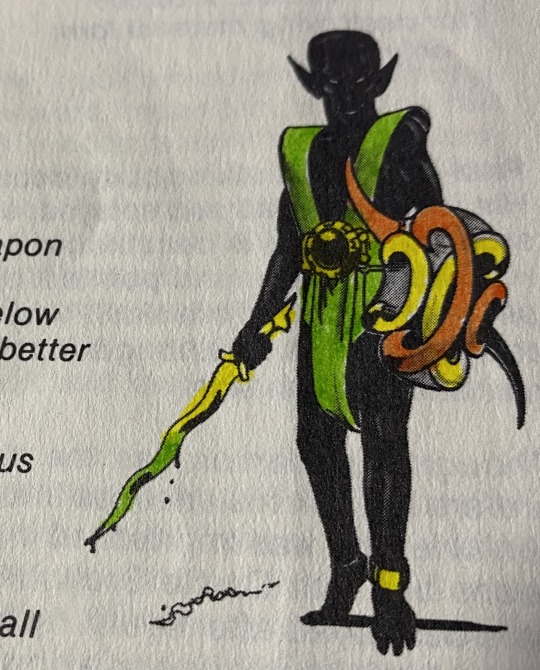
Better quality scan for Graz'zt's illustration (if colored in childhood), by Cullen Burn on Twitter
Further details about him, as shed in the 1987 Manual of Planes: "Graz'zt makes his domain in a great palace that fills an entire layer and dominates the nearby layers of lesser demon lords. Here Graz'zt marshals his army against the forces of Orcus and Demogorgon."
And how Slaanesh's realm is described in 1988's "Realms of Chaos: Slaves to Darkness": GENERAL: Slaanesh is the Lord of Pleasure, the Power of Chaos dedicated to the pursuit of hedonistic pleasures and the overthrow of all codes of decent behaviour. He reigns in a vast and luxuriously appointed palace in the void, where favoured followers litter the floors, indulging themselves in all forms of perverse pleasures of the flesh.
This might be a lesser similarity, but it is curious realms of both are specifically described as "palaces". And as opposed the later lore, the palaces filing the whole realm/dimension in both cases.

Slaanesh, one of his/their's only canon illustrations, exactly from "Realms of Chaos: Slaves to Darkness"
Not 100% canon, but later it's elements (partly) canonized, Graz'zt was connected to Drow in Gord the Rogue series of novels, by Gary Gygax (co-creator of D&D). Specifically, in 1986's "Artifact of Evil", the drow elf priestess Eclavdra converted to serving and worshiping Graz'zt (as did seemingly the drow of Oerth, or at least house of Eilserv, in that continuity), as well as became his lover. And in turn, he helped her to become the queen/ruler of drow. Part of this was canonized since 2nd edition, in 1993's "Iuz the Evil", with Eclavdra being described as worshiping Lolth, but serving both Lolth and Graz'zt. 2006's "Fiendish Codex: Hordes of the Abyss" indeed confirmed Eclavdra converted to worshiping Graz'zt, became his lover (and they even had a son Athux). Seemingly latter serving both Graz'zt and Lolth for a time, before returning to solely worshiping and serving Lolth. Though it makes sense, as Eclavdra was noted in the Gord novels to be certain to betray Graz'zt. This in some ways, makes her similar to the later character of Morathi from Warhammer (Fantasy and Age of Sigmar).
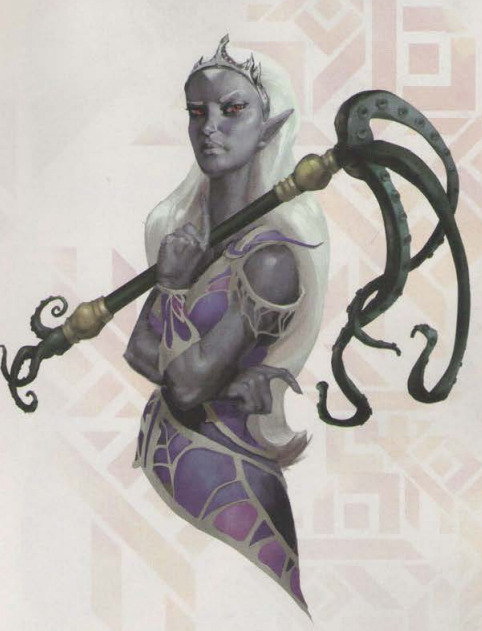
Eclavdra, 5th edition depiction

Graz'zt as presented in 1994's Planes of Chaos
"Iuz the Evil" was also the first appearance of Graz'zt in second edition of Advanced Dungeons & Dragons.
(Also, in 2E, Tanar'ri was the term used for all Demons, unlike later it being used for one, most common category)
Graz'zt and his Realm (now given a name "Azzagrat") was further developed, and changed a bit in the in 1994 "Planes of Chaos", making him , and making him in many ways more resemble Slaanesh: "The best known of the Triple Realm's towns are actually always connected to one another and to the Plain of Infinite Portals; the connections between the three are murky to any mind less chaotic than a tanar'ri's, and sometimes makes travel here extremely frustrating. The towns themselves are often clean and even beautiful, though the streets are still mazes; the horrors of Azzagrat are hidden better than most of the terrors of the Abyss. Screams from behind closed doors are more common than blood in the streets. If a basher doesn't poke her nose in, she might not learn what she don't want to know."
"Other notorious characters include Maretta, the Lady of the Counting-House (Px/fd (succubus)/S2/CE), who watches over the revenues from Graz'zt's pacts with creatures of the Prime. Maretta rules a haven of pleasure and discipline in the underground core of Samora, a city of vice that pays huge yearly tributes to support the Blood War. Maretta occasionally sends a legion of cambion to the front, but for the most part the city is a haven for those avoiding the war. It's one of the few places in the Abyss built with an eye for excessive ornamentation; some say it's as blinding as Mount Celestia, but gaudier."
"A basher'd be smart to avoid the Argent Palace Graz'zt's abode of 66 ivory towers and a hundred cold, mirrored halls - if at all possible. The palace is a frighteningly clean, echoing place where visitors often lose their guides to the ravenous, mad bodaks and worse creatures that Graz'zt releases from his dungeons occasionally for amusement." Here again visible the connection to the number 6.
Second edition also presented Graz'zt's very ambitious plans - of not only conquering/uniting the Abyss, but all of the Lower (Hellish) Planes, and all species of fiends, and march and defeat the Upper (Heavenly) planes (first being detailed in 1996 "Uncaged: Faces of Sigil"). If first via his servant (and possibly child), the Cambion (half-demon) the Rule-of-Three. But this was developed further in 3rd edition and later, and while it seems like an absurdly ambitious plan, it is suggested to be a real possibility.
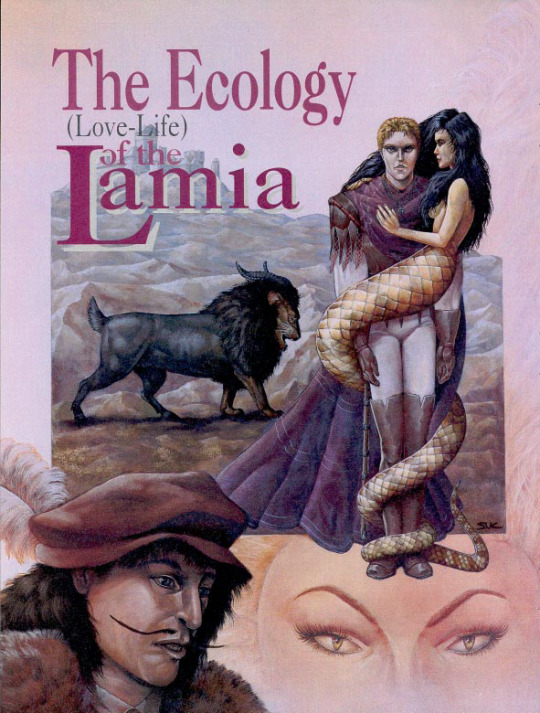
The Lamias, who often serve and worship Graz'zt, are also quite interesting, that in "The Ecology (Love Life) of the Lamia" (found in 1993's Dragon #192), it was revealed that while the Lamia Nnobles (serpentine Lamias) have two sexes, the common (leotaurian) Lamias are hermaphrodites, despite their feminine upper bodies. It's also described that only when mating with a human (and possibly demi-human), Lamias have children of their type/caste - two Lamias mating, produces Lamias of a lower caste. Common Lamias mating with humans of either sex, either being impregnated or impregnating them. Two common Lamias mating, creates a bizarre creature - S'air, the horned lion-goat on the article's cover, a being of animalistic intelligence. S'air are named after creatures of the same name - if spelled by modern translators more often as Sayir, found in the Bible. Often translated as satyrs, goats or devils. In general, Sayir seem to be meant to be goat-like demons, possibly related to latter stories of Jinn, and the Demon/Fallen Angel Azazel. Graz'zt having some similarities to Azazel - especially seeing how the angels name is sometimes written as Azzael or Azzazel (compare to the name of Graz'zt realm Azzagrat), Azazel being father and one of the minds (and fathers) behind the conception of the Nephilim in the Book of Enoch), sometimes described as having six fingers and six toes on each hand and foot (II Samuel 21:20, 1 Chronicles 18-21).
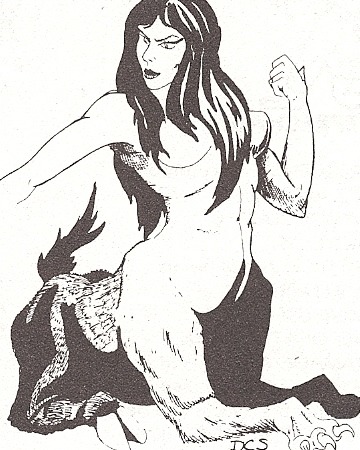
Depiction of a (common) Lamia in the original 1977 Monster Manual. Note her/their hind legs are of a goat
This makes also lamias seem a lot like the Late Medieval and Early Modern folklore about Succubi/Incubi, who were sex switching beings, that had to reproduce with humans. This was latter introduced to Succubi properly, but in 4th edition of D&D (though as will be seen bellow, implied since 2nd edition). What is also very interesting, 3rd edition states (in 2006 "Fiendish Codex I: Hordes of the Abyss") Lamias and Graz'zt are relatives - Lamias being descendants of the Obyrith/Lovecraftian proto-Demoness Pale Night, Graz'zt's mother (as stated since 2nd edition), further showing a close connection between the two.

4E Lamia, partially in her Eladrin/Elven form, from the 2007 Monster Manual
4th Edition, for it's duration, majorly re-imagined Lamias, if still keeping their connections with and worship of Graz'zt. Here they are re-imagined as belonging to the Fey (Fairy) group (along with elves and other faerie creatures). But a truly bizarre example of fairies. Their true form being that of a hive of scarabs, around a Fey (usually elf or eladrin) skeleton, taking the form of an attractive humanoid (most commonly eladrin, elf, drow or human). They devour their victims by first seducing them, by shapeshifting to a look and gender of the target's preference. They also reproduce in a horrific, corruptive, John Carpenter Thing-like fashion, by splitting their scarab mass, devouring a (often first seduced) fey (usually eladrin, elf or drow), aside from their skeleton, and taking their form, along with their memories. Though here being further similar in man ways to Daemons of Slaanesh, and their "relation" to elves and Eldar/Aeldari.

Graz'zt, as depicted in "The Book of Vile Darkness"
3rd edition, starting with 2001's "The Book of Vile Darkness", further emphasized Graz'zt connection to pleasure and desires, as well as started using the using the title "Dark Prince" for him, like Warhammer did for a long time for Slaanesh: "Tales are told among common folk that a dark-skinned fiend sometimes visits witches and sorcerers, granting them both sexual favors and magical powers. Graz’zt is the truth of that legend. A deeply sexual, erotic being, the Dark Prince never goes anywhere without a retinue of female monsters—usually lamias, succubi, or mariliths. He is dangerously charming and seductive, and he speaks with such eloquence and grandeur that one might think him a devil, not a demon."
"Graz’zt loves seduction and guile. Although he is not afraid of war, he would rather trick and charm his opponents than beat them in battle."
"Graz’zt enjoys blood sacrifices made in his name, and sexual rites are important in services dedicated to him as well. His temples are dark, secluded places where orgies are common."
This edition also added to Graz'zt design the fact he has 6 small horns.

Graz'zt as depicted in Dragon Magazine #360, "Demonomicon of Iggwilv: Graz'zt"
5th edition, further developed Graz'zt in Out of Abyss making him again even more similar to Slaanesh:
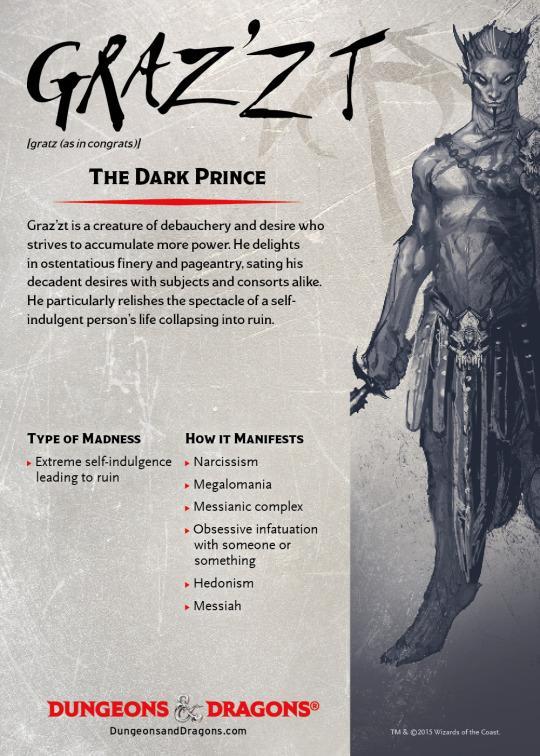
Graz'zt in Out of Abyss' promotional materials
It's also worth to note that Graz'zt, while primarily male, his gender and sex were started to be presented as somewhat fluid (similar to Slaanesh since his debut), starting in Second Edition. In his debut in this edition, in 1993's "Iuz the Evil", he is described: "Graz'zt rules three Abyssal planes and is a powerful tanar'ri Lord. He is proud, and unusually self-controlled and cool for a tanar'ri. His favored form is that of a very tall and heavily-muscled, ebony-skinned man, with glowing green eyes, pointed ears and small fangs. He also has the peculiarity of being six-fingered and six-toed in whatever form he appears in."
This is basically repeated in the above mentioned "Planes of Chaos": "Graz'zt, a powerful tanar'ri lord, rules three Abyssal layers. Also called the Lord of Shadows or the Lord of the Triple Realm, Graz'zt is known for his pride, unusual self-control, and coolness (uncommon for a tanar'ri). He favors the form of a very tall and heavily muscled ebony-skinned man with glowing green eyes, pointed ears, and small fangs. He also has the peculiarity of being six-fingered and six-toed in whatever form he appears in."
These just state he has a propensity to change form...but 3 years latter, in 1997's "Faces of Evil: The Fiends":
"GENDER It's not uncommon for the tanar'ri to take genders as they will. Some days they're male, some days female; some days they're neither, and some days they're both. They tend to stick with one or the other as they grow older, and to all those who think this implies order or stability, why, I argue that it's simply another example of the fiends letting the strongest urge dominate (as they do in all other aspects of their lives)."
Suggesting together Graz'zt probably also assumes female and nonbinary forms, aside from his main form.
This was further suggested in 3rd edition (specifically 3.5E), were Graz'zt was shown, as part of his feud with the Queen of Succubi Malcanthet, transform into/impersonate her, as seen first in lore of the Demon Lord Kostchtchie, in the 2006 article "The Demonomicon of Iggwilv: Kostchtchie: Prince of Wrath" in Dragon #345: "The conflict between the Dark Prince Graz'zt and the Queen of Succubi Malcanthet is one of the most notorious in the Abyss. When Graz’zt hit upon an idea that would not only humiliate Malcanthet but might provide him access to the Stoldottir Gate, he put a dangerous plan into motion. Disguised as the Queen of Succubi, Graz'zt managed over the course of hundreds of clandestine meetings to seduce Kostchtchie and gain his trust, convincing him that, as Malcanthet, he wanted to be Kostchtchie’s bride and merge their resources to destroy several other demon lords."
Kostchtchie, thanks to the real Malcanthet's manipulation on her own, discovered the truth, and went into a complete rage. But what is interesting, it's also described as such: "Yet to Kostchtchie, nothing could have been more humiliating. His realization that he had been manipulated by a woman (even if that woman was actually Graz'zt in disguise) fueled his misogyny like never before, and the fact that the other tanar'ri lords (Graz’zt in particular) now viewed Kostchtchie as a besotted fool triggered one of his greatest rages ever."
Stating Kostchtchie considers Graz'zt at least partly a woman, and even the text seems to partly agree. And this even fueled Kostchtchie's misogyny, not homophobia, or any form of queerphobia.
Graz'zt again impersonated/transformed into Malcanthet in 2007's "Expedition into the Demonweb Pit", as part of his plans:
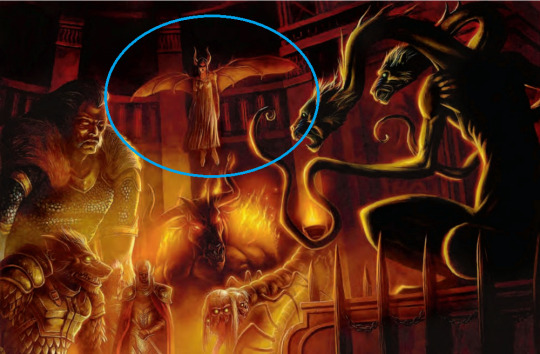
Graz'zt impersonating Malcanthet, circled
And in 5th edition, in "Out of Abyss": "The appearance of the Dark Prince is a warning that not all beautiful things are good. Standing nearly nine feet tall, Graz'zt strikes the perfect figure of untamed desire, every plane and curve of his body, every glance of his burning eyes, promising a mixture of pleasure and pain. A subtle wrongness pervades his beauty, from the cruel cast of his features to the six fingers on each hand and six toes on each foot. Graz'zt can also transform himself at will, appearing in any humanoid form that pleases him, or his onlookers, all equally tempting in their own ways."
In general, these similarities, and possible inspirations are very interesting, especially how it seems Graz'zt and Slaanesh started to mutually influence each other.
#slaanesh#graz'zt#dungeons & dragons#advanced dungeons & dragons#dnd#inspiration#mutual influence#warhammer#40k
27 notes
·
View notes
Text
The Yawning Boredom Of The Word Epic
Good god this is a dull word, right?
Cancon was a fun convention, I liked it a lot. But while I was there, I saw this word being worn into a groove in my brain. It was an all-purpose descriptor, a vague and generic positivity, a detailer of scope and an encouragement for engaging, and every time I saw it I felt a bit of my brain shut down in response. I think some of this is just the normal overuse of meaningless words. If someone described a game as being ‘lit’ I would probably also just as much immediately ignore that descriptor. Packing peanut language, that kind of thing.
And I know it’s rich, coming from me to complain about overuse of cliche. I just said ‘packing peanuts’ which is something I am very selfconscious about saying a lot.
It’s not just the ungoogleable game Epic by Wise ‘Maybe We Don’t Want To Be Called White Wizards Any More’ Wizards. It’s also games like Epic Spell Wars of the Battle Wizards: Duel at Mt Skullzfyre or Epic Resort or Tiny Epic and their franchise of genuinely exciting little games, or Crafting Epic Dungeons or Epic Scenery or Epicness Incarnate or Warhammer Epic or Epic Confrontation and you might not know if I made any of these games up, or all the other things I saw on the convention floor that just kept using the term, and every single time made me realise that in so doing, I now knew less about them than I would if almost any word was in that space.
What is ‘epic’ for?
I saw it being used to describe campaign sourcebooks and TTRPG material. It’s an interesting quirk of language that back when I was playing 3rd edition D&D, epic was a specific term used to describe the game after 20th level, which is to say, the point when the game’s rules started to break down and all the power design got exceptionally dumb. Of course that’s an old term from an older time – 3rd edition hasn’t been a meaningful frame of reference since the ye olden times of 2019 when Pathfinder 2e came out. In 4e — the best edition — the term is used to describe the last 10 levels of the game, where the game stops being about the movement of heroes and monsters and starts being about the will of demigods and resolutions of kingdoms.
Still, it looks to me now like ‘Epic’ is a thing that is used to describe a campaign that is long and has a huge scope. That’s cool and all, I can imagine a reason to want that, but I think this runs into a problem I have with the landscape of TTRPGs with prebuilt content in the first place. I don’t actually have much interest in modules or campaign setting information myself because I will almost always want to make my own, to tell my own story. Buying a campaign is weird enough to me, but then buying a big campaign, especially an extremely long campaign has all the aspirational purchase energy of the kind of person who buys roof racks for their sports utility vehicle that’s never going to be used to drive anywhere but work in the city and the shops.
Epic dungeons are somewhat in the same space in that they’re very large commitments of time and energy to a large space. Spaces are interesting to me because a space has an ideology and a purpose. The nature of a dungeon is that it’s a place with a purpose and you have to work out exactly what that means for a world — if there’s a dungeon the size of the Imperial City underneath the ground somewhere with its own ecosystem, I’m left wondering why it’s there, what’s the ideology of a structure like that.
Epic Dungeons are Dungeons, but big! Dungeons where you go down into them and what, have to spend time making beachheads and establishing places you can come back to? This is an idea that always feels to me like it works better for a videogame like Diablo, where there’s a system in place that lets you ‘save’ your progress, or a game world like Dark Souls where you can operate completely at your very edge of survival, where the nature of the place you’re going gives you a chance to restock yourself, and you don’t have to leave it except to empty your pockets.
And like, those worlds make for fun videogames but that’s a videogame? There’s no sense of verisimilitude or ideology of place in a videogame, certainly not compared to the vast freedom of a TTRPG. Yes, I’m saying Dark Souls is worse at giving a sense of place and a world than graph paper. And I should, because I’m right.
So like, what use is an Epic Dungeon as a thing you buy and drop into a world? It seems like you need a world that’s made for it, a world where it made sense for there to be an epic dungeon and a playstyle that supports it.
Epic challenges also feels like a strange place to start because what about them is epic? The scope of them? I guess that can be a way to make something feel big and impressive, but when a RPG sourcebook is promising ‘epic challenges’ I have to wonder how they make that feel that way. I remember keenly Exalted with its vast scope and how little that scope felt like it existed or mattered because the world kept winding around the same four or five people and the same villain. Are these games full of really good structural design that allows you to convey a deeply complicated scale of a problem with a huge variety of variables in a meaningfully handleable way? Or are they just full of art that shows very big things? Is it a dwarf with a big axe leaping through the air? Because that just feels like heroic fantasy, and I’ve got that.
I feel that in some cases there’s also an element of low-key snobbery around some of these ‘epic’ encounters where what they mean by ‘epic’ is ‘players can fail.’ Like there’s something about ‘epic challenges’ that means I know how to represent a real challenge, you don’t, and with all this there’s the precarity of a failure state hovering over things, a failure state that, being honest, for an appropriately epic sized kind of challenge, you won’t really see, because, like…
You don’t tend to survive epic failures.
Worlds don’t tend to survive epic failures.
It isn’t that any of the time, the impulse to use the word epic is a bad thing. It’s not like any of these companies are going to hurt for using a word that I personally just happen to think exists at the same level of writing effort as a gamer webcomic about two guys on a sofa complaining about the size of an Xbox controller.
I predict if Ettin gets to read this, he’s going to, before he finishes reading the article, send me a discord message saying ‘lol, epic.’
Check it out on PRESS.exe to see it with images and links!
2 notes
·
View notes
Text
306. Garry Spiegle - AC3: The Kidnapping of Princess Arelina (1984)
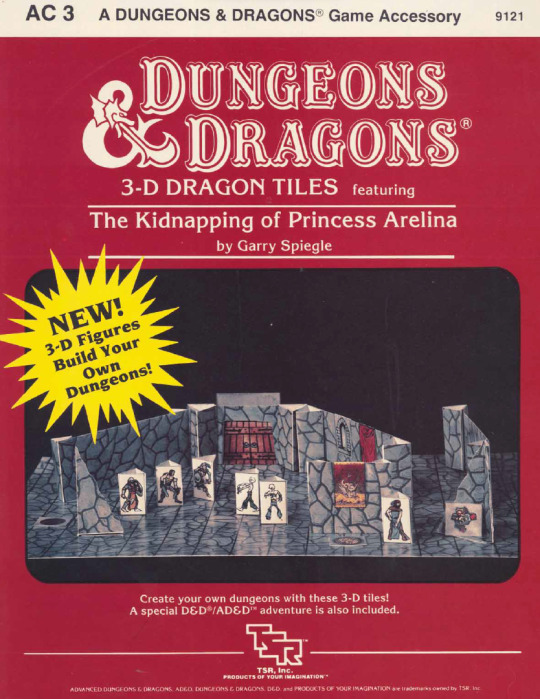
A module that is both adventure and DM accessory, this is particularly notable for the cardboard pieces that can be used in this or other adventures, these include 3D character models and floor tiles that you can use to build your dungeon.

Together with the cardboard accessories you get a small and straight forward adventure of the "rescue the princess" style. Not much to say about that, except that it does have the interesting distinction of containing, in each room, details on how to set it up using the pieces provided.

So, more of an accessory than a module, really, as the adventure is a bit ho-hum, it's still a pretty interesting D&D product, which was also compatible with AD&D (obviously) and started the Dragon Tiles series, which would have plenty more entries through the years.

2 notes
·
View notes
Text
i think what could be really cool is a dungeon crawler game, but the dungeon is a mix between a randomly generated one and something like the temple of the ocean king from Zelda Phantom Hourglass
The rooms are still random, but the further you go, the more it changes, so you can collect more different (and better) materials the further you go in.
But many rooms have shortcuts you can take to skip several floors at once, shortcuts you can take once you've reached a certain milestone. Personally, I'd make those milestones certain items that you can also fight enemies with.
I think one of the most interesting parts of the temple of the ocean king is how throughout almost the entire game, you can't kill the phantoms unless the environment is rigged to allow it in some way, like boulders you can push or trapdoors that you can open. And even if there are no traps in the phantoms regular route, you can still lure them there and kill them that way.
So i guess a dungeon that's like chockful of loot, not only from monsters you might defeat, but also from chests that you have to find. And then you also have unkillable guardians that you have to either avoid or use the dungeons own traps to get out of the way.
There's no hard time limit, "hard" meaning that once time runs out, you're instantly dead. A soft time limit would be what Phantom Hourglass did. Yes, you have a time limit, but that's the time limit for how long you'll be protected. Once the hourglass runs out of sand, you don't die right there on the spot, but you do start taking damage outside of the safe zones. I think that's brilliant, because that makes the time you DO have seem MUCH more precious than if you just died right then and there, it makes you hurry from one safe zone to the next, or at least that's how i always percieved it. Getting caught by the phantoms also didn't kill you, but it did rob you of valuable time while also sending you back to where you came instead of throwing you out of the temple. And I actually think that's pretty neat! It gives you enough incentive to avoid getting caught, while also not punishing you so much that you never take a risk. That's a good balance if you ask me!
In a dungeon crawler, you could pick a difficulty setting. The more difficult it is, the better loot you get, BUT the punishments are also harsher. If a dungeon guardian gets you, you get sent back a floor or two. If there's a time element, more time gets robbed from you. Regular enemies are also harder, but drop better loot as well, chests are the same.
If there are keys needed to proceed to a deeper floor or to get to a chest, an unkillable guardian would carry at least one of these keys, and you have to either use a trap to kill it, or use an item to take the key from it. If you can stun them, you could also do that and they'll drop what they're holding, but they're only stunned for a moment, so while that's the quickest method, it's also the riskiest. You have to do this one several times in the ocean king temple, but you could also use items to take things they were holding from them directly. My love for items may or may not stem from the way that they allow for creative game design. (I really love items and I'm sad that botw pretty much abolished them. The sheika tablet modules do not count, because the only one that has a regular use are the bombs and that's... exactly 1 item. The magnetism is mainly used for a few shrines and korok seeds. Uses for the static module were so rare it was practically a novelty item. Plus, you got all the modules at the start of the game and then that's it, nothing changes.)
0 notes
Text
3E was the turning point for D&D specifically. Well, the seeds were planted with the Dragonlance modules switching adventure design from self-contained dungeons to a series of set-piece encounters, but 3E formalized it.
Older editions of D&D designed encounters based on where they were located independently of the party's levels. Deeper dungeon floors had more powerful monsters, and the wilderness had larger numbers of monsters. Other than that, the players chose where to explore and what risks to take.
I don't know what methods were used to come up with the suggested character level ranges for published modules, but they varied wildly by modern standards. You'd see things like "Levels 6 to 10 with 45-60 total levels" i.e. a party of ten (!) sixth level characters was expected to both exist and br roughly equivalent to six 10th level characters. If they find something they can't handle with numbers alone they're expected to flee and find alternative solutions.
D&D 3E was the first to aim for balanced encounters. Expected balance points were established for both individual fights and the number of fights in a day. Archetypically four standard encounters in each day, expected to bring the party as a whole down to about 20% of their HP and daily resources. More fights if they're easy, fewer if they're hard.
3E established combat as the only way to get XP and as something the characters are expected to win. That it's OK for the wizard to just win some encounters because there will be too many fights in one day for the wizard to solo them all. That you'll use most of your spell slots every day because you got into that many fights. That you'll find your weight in gold by 10th to buy the fighter her +3 sword - and more besides for her other equipment!
There are advantages and disadvantages to that design.
Thinking about 5E's adventuring day and how D&D heroes are expected to get in a bunch of fights every day to show off how cool they are (thanks to @thydungeongal 's Jul 10 post) and, like, film and TV where fights seem to happen just to keep interesting stuff happening on the screen rather than in service to narrative or characterization. Just, like, the difference between choreography and pacing between the Star Wars sequel trilogy and the OT. The OT is not always perfect, but the action often feels weightier and more impactful than Rey, Finn, and Poe scrambling from one action set piece to the next while breathlessly shouting exposition.
I'm not sure if modern D&D is the way it is because it's reflecting the popular narrative conventions of the day or if it's a coincidence. I think, mechanically, it's partially down to uncritically reproducing how 4E paced itself. But 4E was explicitly a tactical skirmish TTRPG in ways 5E really isn't.
82 notes
·
View notes
Photo
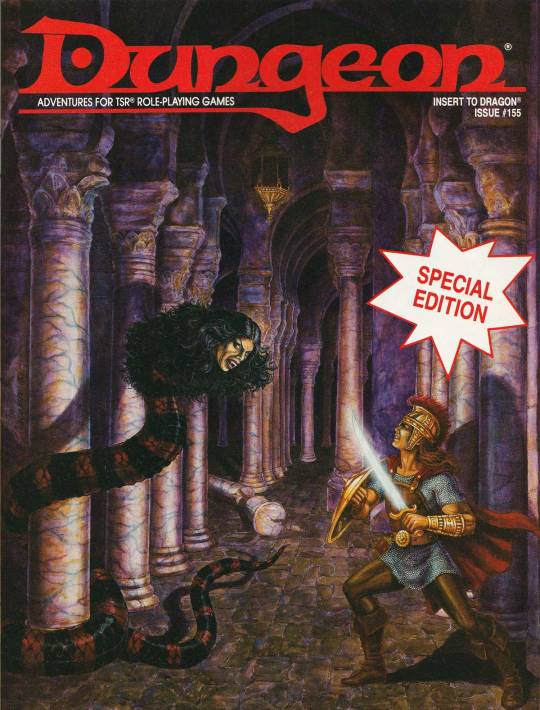
Confronting the spirit naga in “The Crypt of Istaris,” Richard Fichera’s AD&D tournament module from the Gateway ‘85 convention, printed in Dragon magazine 155, March 1990, as a special Dungeon magazine insert (edit: art by James Faulkenberg -- thanks, @mrdestructicity, for pointing out the signature along the left edge -- I zoomed in on every line in the floor tiles and every vein in the marble columns before giving up on finding one)
#D&D#Dungeons & Dragons#spirit naga#dungeon#Dragon magazine#Dungeon magazine#fighter#magic sword#The Crypt of Istaris#crypt#columns#naga#dnd#Richard Fichera#Gateway convention#Gateway '85#1980s#TSR#Dungeons and Dragons
220 notes
·
View notes
Text
youtube
Module: Programming for 3D : G6080
Task: Demonstrate your profiency in basic unity fundamentals in game design.
Skills Acquired: Unity (Particle systems, Game Mechanics,Texture, Spatial Sound) , C++ Scripting
Game Controls:
E: Pick Up Object
Right-Mouse Button: Throw Object
Game Objective Summary
Characters: Main player.
Action: Player must initiate the spawn system and pick up spawned object.
Action: Player must also step on tile in front of the main door to open it and step on the tile behind door to close.
Action: Player must throw spawned object downstairs.
Action: Player must collect items, survive and avoid traps.
Player Goal: Collect 10 crystals orbs to escape the dungeon.
Flowchart: No decisions made at this point: If level is completed, player wins the game. If player takes full damage during gameplay revert to game over overlay and prompt to try again.
Scene 1:
Location: A narrow hallway dimly lit by torches, with elevated tiles on ground and door at the end.
Scene 1.5:
Location: Stairway to the second floor.
Scene 2:
Location: Room filled with traps, crystals, and other assets.
Scene 2.5:
Location: Trap-infested hallway, stairway to third floor.
Scene 3:
Location: Dimly lit room with an ancient platform.
Music: Mysterious background music surrounds the environment as the game goes on.
Notes: Player is trapped in the dungeon, The only viable way out is to collect crystals, avoid traps, and activate the platform.
0 notes
Text
#1 Game Goal, Assets, How to Play
Here I go over how my thoughts on how the game should go. Similar as possible to Decked Out, but modified to be more like a boardgame so there's no real-time events. There will probably be some overlapping explanations as I go into more detail on the assets themselves in later posts, but I'd rather overlap than omit something important.
So this is more of a tool to go alongside dnd rather than being a written module campaign like curse of strahd. More like inserting dnd into a board game. It might work, it might not. Will have to test. After the cut I go right in with how I think the game will work.
Aim of the Game:
Run the dungeon, collect artifacts, survive, upgrade your deck, do higher difficulties until you can escape.
Assets:
Boards
Dungeon Board: Where the Room Cards are placed. There are twenty spaces on the board. These are labelled from A1 to E4. Level 1 connects the Hub area in the corner to the Dungeon area.
Room Board: When players are in a room, they are placed on the Room Board, which acts as a map and allows them to move on a grid and see their surroundings such as the environment or enemies.
Cards
Room Cards: x20 Lvl 1, x20 Lvl 2, x10 Lvl 3 cards. Room cards contain a preview of a room that the players will explore. Each card is placed face down on the appropriate difficulty board, and the closest one to the waiting room is flipped up when the players enter the dungeon.
Each card also shows four pathways, one on each edge of the card, and the players decide which pathway to take and flip over the card in the chosen direction, then flipping the room card they were just in face down again. Room cards will have 1-4 pathways that are red. These can close off when Hazard is played.
Clank Cards: A deck full of Clank cards. 20 Clank cards are shuffled into the players’ deck at the start of a run.
Player Cards: These cards are for players to purchase and use. There are three main types:
Normal: These cards are played when drawn during the dungeon.
Ethereal: These cards are removed from the deck after being used and can only be used again if purchased again.
Permanent: These cards activate automatically at the start of a run.
In addition, there are tiers of cards going from Crown, Common, Uncommon, Rare and Legendary.
Artifact Cards: These are drawn by the Dungeon Master at the start of a Run. They are separated into lvls 1, 2 and 3. The number of Frost Embers awarded for retrieving the artifact is written on the card. The location of the card is written as A3, C4, etc. and relates to the notation on the board. They also show locations where Ravagers spawn.
Treasure
Crowns and Fragments: These drop throughout the dungeon during a run. Four Fragments can be converted into a Crown, which can be converted into Gold. Gold can be used to purchase items and Crown Cards.
Keys: These sometimes drop with other Treasure drops. A key is required to access the next floor when doing higher level runs.
Frost Embers: These also drop throughout the dungeon but are separate from Treasure. The main way to acquire these is to retrieve an Artifact and return to the Hub alive. These can be spent to buy more powerful cards.
Monsters
Cruel Monsters: Spawn when sufficient Clank is generated. These are forces of nature that deal a lot of damage, cannot be killed.
Ravagers: Large, hog-like monsters that charge at you when they see you. There are a certain number on each floor and spawn in locations depending on the Artifact. These will follow players to new rooms unless they lose sight of them.
Vex: Only spawns at Max Clank. Hostile ghosts that fly at players relentlessly.
Wardens: Only spawn on level 3. Blind, but can hear very well and shoot sonically charged shriek projectiles.
Room Monsters: These can appear in certain rooms when the players enter. These will not leave the Rooms they were found in. In general, they are significantly weaker than Cruel Monsters.
___________________
My main concern right now is I might potentially have too many card types. I plan to make some visuals as far as the board and cards go so that it makes more sense. When I do that I might make this post again but with pictures to make things clearer.
___________________
Setting up the game.
Shuffle the Room Cards and lay them out on the Dungeon Board face down in the appropriate levels.
The players are given a deck with three cards in it: Treasure Hunter, Ember Seeker and Moment of Clarity.
This deck is what they will build throughout the game by buying cards with Frost Embers.
The players start the game inside a Hub area that has NPCs which can sell every dnd item at the normal price. They also have their starting equipment.
Before running the dungeon, the players should prepare their items and deck.
The players are given a deck with three cards in it: Treasure Hunter, Ember Seeker and Moment of Clarity.
This deck is what they will build throughout the game by buying cards with Frost Embers. When the players finish preparations, they can run the dungeon. First, select difficulty level: 1, 2 or 3. This determines what level of the dungeon the players must reach. Second, the Dungeon Master draws a card from the Artifact Deck of appropriate level, which tells the coordinates and Frost Ember reward.
__________________
Running the Dungeon.
Players shuffle 20 Clank Cards into their deck. The players are not allowed to see the deck during a run (as Clank Cards have a different coloured back).
When the players enter the dungeon, the DM only tells the players if the Artifact is North, South, East, West or in between two. Each time the players enter a new room, the DM again tells them.
When entering the dungeon, players begin in the bottom-left space of the board and flip the card over. Each Room Card represents either a social, combat or environmental scenario that the party must resolve. After doing so, they can choose which direction to go. After deciding, they flip over the next Room Card and flip the previous one face down. When players acquire the artifact, they must return to the Hub with it. Players can return to the Hub without an Artifact, but any other items acquired such as Treasures or Frost Embers will vanish. During a run, players must be wary of Clank and Hazard.
Depending on what Artifact was drawn, Ravagers will spawn in certain rooms. If a Ravager sees a player, it will pursue them until it either kills them or loses sight of them, even chasing across rooms.
____________________
Clank
Clank is an effect that builds up over time. It has no effect until it is maximised.
Some ways Clank can be generated include (but are not limited to):
Drawing a Clank card from your deck.
Each time a new room is entered, 1 Clank Card is drawn from the Clank Deck.
After finding the Artifact, 3 Clank cards are drawn.
Certain cards will cause Clank cards to be drawn when played.
When an hour passes in-game, 2 Clank cards are drawn.
Clank cards are placed on the side of the board. When w0 Clank cards are in play, it is Max Clank, and no more cards are drawn any deck until the run is over. When Max Clank is reached, one Vex spawns for each player, and they will pursue and attack the players through the dungeon.
Clank can be prevented with Clank-block cards. A card with Clank-block displays a number of how many Clank cards it can block. The next Clank cards drawn (up to the number of Clank-block shown) are placed on top of the Clank-block card and do not count towards Max Clank.
Clank resets at the end of a run.
Hazard
Every time a room is entered, or an hour passes in-game, the players gain 1 Hazard point. When a Hazard point is gained, the DM flips a coin for each Hazard point. If the coin is Heads, nothing happens. If it is Tails, the red Hazard door(s) marked on the Room Board closes off and can no longer be traversed through. Hazard Points reset at the end of a run.
Artifacts
Artifacts are obtained in the room that they are designated to. The room will have either a social encounter, combat or environmental puzzle to solve. When solved, the usual reward is replaced with the Artifact. Players must return to the Hub with the Artifact to get any reward.
Treasure Drops
Each time the players enter a new room, a coin is flipped number of times depending on the dungeon level. If it is heads, the room contains Treasure. The DM rolls a d6. On a 1-5, they find that many Crown Fragments. On a 6, they find a key. Cards can increase the amount of Treasure found as well as how many coins are flipped.
Crown Fragments have no value on their own and vanish upon returning to the Hub. However, four Crown Fragments can be combined into one Crown, which can be taken out of the dungeon. Crowns can be spent at the Crown shop or converted into Gold Pieces (GP). 1 Crown is equivalent to 100 GP.
Keys cannot be used at shops but are required to access higher level floors. Keys must be brought to the correct Room Card that contains a Staircase.
Frost Embers
These can only be acquired by retrieving Artifacts or with cards that generate them. When the players return to the Hub, they can spend them on cards or other exclusive items. They cannot, however, be stored. When a new run is started, any unspent Frost Embers vanish.
Cards
These can be purchased from the Frost Ember shop in the hub. The more cards added to the deck, the less likely you will draw a Clank Card and the more likely you are to draw a beneficial effect instead. Decks can hold a maximum of 40 cards and a maximum of 5 of the same card. Should the players acquire more than 40 cards, they must select which cards to leave out when they enter the dungeon.
___________________
This is where I start mixing it in a little bit with DnD. In a typical campaign setting, you get gold from doing quests and stuff. In this one, you get it from running the dungeon and returning with the Artifact. I wanted it to still feel like DnD and so not be as defenceless as actual Decked Out. Important to note, Ravagers and Vexes can't be defeated, so their weapons and stuff will be mainly for Encounters in the Room Cards.
_______________________
Finishing a Run.
After the players successfully return to the Hub with their Artifact, Frost Embers and Crowns, they convert the Artifact into Frost Embers and can spend them to buy cards and other exclusive items at the Ember Shop. Crowns can be spent at the Crown shop or converted to GP to be spent on dnd items.
Frost Embers cannot be stored and vanish when starting a new run. GP and Crowns can be stored and saved up.
How to Win
Successfully returning from a run is all well and good, but it’s not quite enough to win the whole game. For that, the players must save enough Frost Embers to purchase a Black Key. The Black Key must be taken into the dungeon on the highest difficulty level and brought to the correct Room Card containing the Door of Victory. Entering the Door of Victory brings you to the final level, and only by completing the final level can you truly escape Decked Out…
_______________________
Again the part about GP is for the dnd part. If I make a standalone version of this I may remove it entirely.
I'm not really sure how to order these segments. I think I need to actually talk and explain to someone out loud like I'm trying to teach them how to play so that I can work out what order to do it in. Again, I think visuals will help so I'll work on those soon.
That's all for now, next post I'll try to do this one again but with pictures accompanying it.
1 note
·
View note
Text
The issue is complicated somewhat by the fact that D&D hasn't always been a combat game.
Before 3e¹, D&D was firmly a dungeon crawler: a chiefly exploration-based game, with combat in it. Players were expected to use their wits, not fight everything head-on, and there were concrete mechanics for things like morale (monsters might run away!)², evasion (players might run away!), and reactions (monsters might be friendly!). 3e still had plenty of exploration mechanics, sure, but there was a shift here, and D&D became a combat game. For the first time, there were mathematical formulae for ensuring "encounter balance," a concept mostly foreign to 1e, 2e, and BX³, and thus the expectation that they should be used. (To 3e's credit, the Dungeon Masters Guide advises DMs to change things up and not just use medium encounters all the time, but nobody listened to this--including the majority of official modules.)
The issue is that D&D pretends to not be a combat game, and WOTC pretends D&D isn't a combat game, and people believe it. 4e didn't pretend to not be a combat game and people got mad, so 5e went right back to pretending.
¹Later 2e supplements (Players Option series), especially Combat & Tactics, started to push things in the direction of 3e, but the base rules were still there.
²DMs were always told that whatever made sense in the moment should supercede rolling dice for morale, but systems for rolling were still presented. 2e's were really robust!
³old D&D did actually care about game balance, but it was generally more on a macro level. In large dungeons, dungeon level and character level were considered to be roughly equivalent (alternatively, you could have a one-floor "level X" dungeon); for published modules, "an adventure for characters level 1-3" didn't mean "this adventure will take characters from level 1 to level 3," but rather "this adventure can reasonably be taken on by characters of level 1, 2, or 3."
I've talked a lot about the specific types expectations that post-TSR D&D encodes in its players and I do think it's funny how some of the stuff I talk about sometimes seems to feel, like, huge and revelatory to people.
"What do you mean not all RPGs assume the player characters to be an adventuring party that goes on adventures together? What are they even supposed to do if there's no adventure?" Assume that D&D is like an Avengers film, about a group of heroes assembling and going up against adversity to save the day. A lot of games are soap operas, where the players create the central characters, pro and ant agonist alike, and then they're thrown into a powderkeg together.
"If there is no challenge rating or similar mechanic, how is the GM supposed to know if a given combat encounter is something the player characters can overcome?" A lot of games don't have combat encoded into the game as an activity that characters are expected to partake in just to demonstrate their strength. In fact, if combat does happen in lots of games it's usually as a last resort and something that requires an active player choice for it to happen. You won't get ambushed by bandits who are willing to fight to the death for no discernible reason just so your characters can demonstrate their strength and get one of their daily intake of five combat encounters a day (or whatever number games assume these days idk).
"Wait, there are modes of play besides combat that can have deep and granular rules? How can such a thing even work?" It can and it rules.
1K notes
·
View notes
Text
Pre-G1 Modules, part 4B - The Judge's Guild Roundup Completed
Oh. Oh we're still doing this? It won't end? Gods. At least we made it to 1978. Anyway, happy eclipse to every. Reminder: the people who run Judge's Guild now are full-on nazis, do not buy their books. Go hug your loved ones instead.
The Thieves of Fortress Badabaskor (1978)
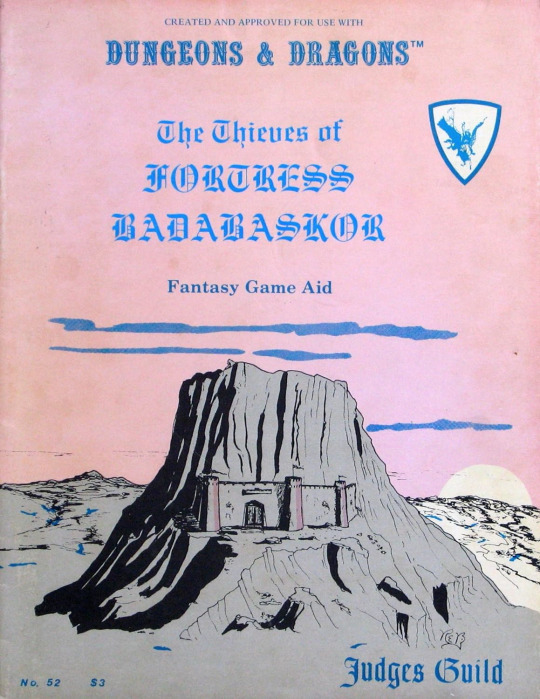
Maybe I was too hard on the Prince Valiant-ass artstyle. It looks very proud for a bandit fortress, don't you think? The full color version that comes out later is even nicer -- it's the one you find on google images first. Anyway. Fort Badboybaskaur was founded by ''The Emperor of Glorious Doomfire''. It truly was the era of so-bad-its-good naming! The fort was built so that if raiding happened, the many small villages could congregate there for safety. Only, it turns out there was a red dragon underneath. And then that got resealed. And then an evil demigod took over. And then bandits took that over.

I read this section like five times and for the life of me I cannot find a prophesy here. They just kind of say it because it sounds cool. The prose in this hand out is, really really rough, it's a lot of proper nouns and moral history tropes -- empire becoming successful and spawning evil religion yada yada yada. The proper noun addiction is strong with this one, we get quite a few undefined proper nouns here. He's another classic: "Zanaaphic the All-King of the Spirit Universe". I have so many questions! None of which will be answered. "Angall of the Perpetual Void" Wow! Those are some neat nouns! The net effect, however, is there was a really skilled evil wizard who got confronted by a god, beat him, and by defeating him became a four-armed dragon-skinned bat-winged magical null. He does up to 16 pips of damage with his silly flails!
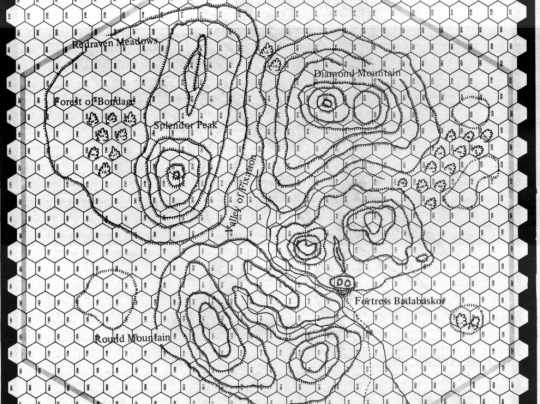
So the cover image is lying a little bit about the fortress. In both of the presented maps, there is no cool rampart that you have to slowly siege, there are mountains both in front and behind the fortress, and there are way more than three turrets. I am actually a little fond of this keep layout-wise, it's less cramped than the Keep on the Borderlands is. Naturally, it sits at the foot of Mount Deception.
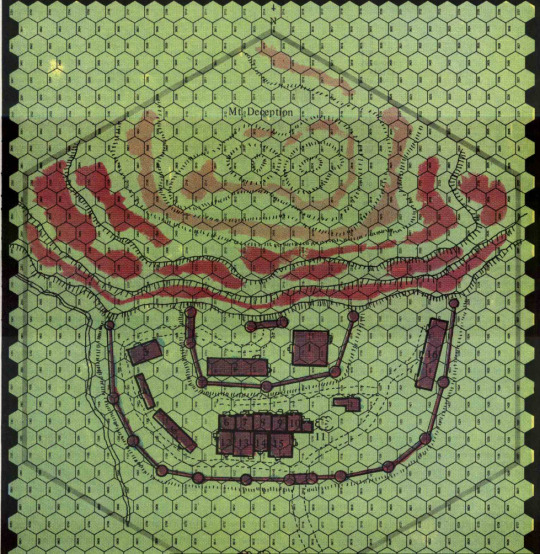
It's a nice little fortress, no? I would recommend getting a modern copy of the map if it wasn't for the ownership sucking ass in an extreme way. Plus, having dungeons under your keep on the borderlands seems like a great idea, actually. Or, shit, having a rival keep on a rival borderlands sounds kinda rad. Anyway, the room by room is pretty rote. The exterior rooms are mostly just services you'd give to anyone walking in, but the real juicy stuff is all kept inside the mountain walls. We've got your usual suspects. Guard captain, bossman, bossman's terrible wife (and the wife is legally required to be evil because male writers), pawnbroker, human trafficker, tavernsssssss, gemcutter, blacksmith, et c. Some of the names are okay, "Hole in the Hill Inn" run by ogres was really funny to me, I would change them to hill giants to complete the joke.
The dungeon has an interesting conceit where there are some generic "alternate rooms" in the back of the book that come with a blank room number that you can swap if you dislike the default room contents. I'm really in favor of this mindset. I have thought for a while that it'd be kind of nice for adventure books to be shipped in some sort of editable capacity? Like if I wanna do open heart surgery on a floor of a dungeon, but I like the other 4 floors, it'd be nice to keep it in the original format instead of having the adventure book and then some loose-leaf with the changes penciled in. Tragically, the alt rooms are overwhelmingly just monsters in a room, with the outlier being a wererats with a little kidnapping scheme.
Underneath the fortress there are five levels, one is actually above ground level and in the cliff face behind the keep, and the third level leads to the surface via caves. Neat! I'm kind of imagining Gerudo Fortress here on a lot of levels. Here's a quick skim of the best contents:
There appears to be a little rat treasure hoard where the rats have to pay their dues to their little rat kings? What's going on here is kind of unclear to me, but I can't help but imagine one of the guards trained the rats to hide money in the walls for him and the ten rats with silver formation are a kind of animal-passcode.
A chest trapped with some sort of reverse truth serum -- it removes your ability to speak, see, or hear for a week if you open it without permission. Naturally, the chest is decorated with the three wise monkeys 🙈🙉🙊 (and a mysterious fourth monkey the text implies nothing about, maybe it's Sezaru? Curse of erectile dysfunction!)
The alarm system seems to be gong-based
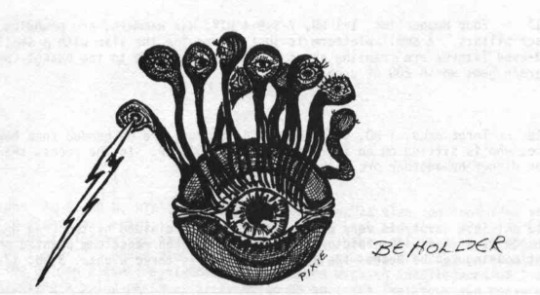
Oh, I don't like this beholder at all. Ewwww! But also, why is this drawing here? There's no beholders in here? Is this some kind of silly trap for snooping players? In fact, most of the monster illustrations are…kind of just random monsters.
The treasury is booby-trapped to hell and back. We have a standard guillotine trap disarmed with a tile puzzle on the wall, a hell-hound guard dog, and the most prominent magical item is a necklace of strangulation. Rough break! Just go ahead and put all of the treasure on pressure plates with flame jets at that point.
A reverse gravity pit-trap -- you pull a book, you fall through a hole in the ceiling and then it traps you in the ceiling. It's just a pit trap at the end of the day, but way vivid!
A chair made of a dragon's arms and horn that will animate and attack you if you try to pry gems off it or attack anyone
Two wizards are having a battle over who gets to own a trained lizard that can sing and carry heavy loads. I understand guys. That lizard is worth it.
Under a sarcophagus is written "If you can read this, you're too close", as well as some explosive runes
The treasure hoard of a lost king, if you attempt to steal it, will turn into a treasure construct shaped like the king. Awesome!
"A similar cabinet on the north wall is labeled "For Future Imperialists". In the top drawer is a Gem of Brightness, the second is a pair of Bracers of Defenselessness, and in the bottom drawer is a pouch of Dust of Sneezing and Choking." I would fully lean in, make it a Cursed Gem of Brightness that you can't turn off, and put the Bracers in the top drawer if the goal is to prank an evil character into hurting themselves.
A reverse-vampire giant lizardfolk that consumes the unlife from undead. So, Tomb of the Lizard King got beat to the vampire-lizardfolk punch, I guess?
Large swaths of this dungeon genuinely feel randomly generated. The worst parts are about half of floor 2, 3, and about half of floors 4 and 5. It just feels like padding to me. And in true Judge's Guild fashion, there are treasure stores in the temple that are "instantly max your character" amounts of loot. Now I get that shares are a thing and you gotta pay your hirelings, but still, 1.5M gold represents like, even if you're a party of 10 you're still looking at instantly maxing a thief, shooting a fighter to level 8, and shooting a wizard to level 9. And there's no way you were at 0xp when you smuggled that statue out, that's going to be an instant max for just about anyone. The big reveal that I…guess you could conceivably puzzle out? Is that the dragons were nearby because they were minions of a dragon-king entombed under this fortress before it was built. A cool idea, that desperately needs more foreshadowing. The love clearly went into making those tombs cool, so if I was going to rip anything off from this module that'd probably be my second port of call.
Gen Con IX Dungeons (1978)
What a name, right? How come Tsojconth got a name and these dungeons didn't? Blatant favoritism. Well actually one of the two dungeons may as well be called the Halls of Grsk. And, wow, everything about the design notes are ominous. "Simplicity would be the prime requisite". So….does that mean this adventure is boring on purpose, Bob?
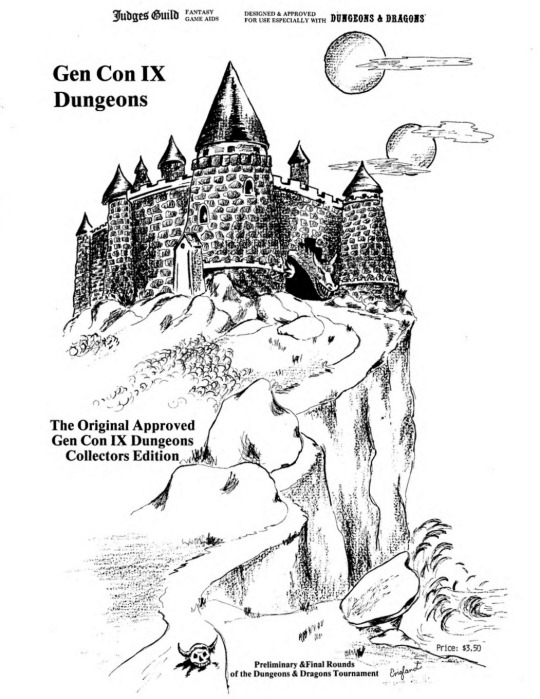
The adventure is split into two bits, the player-side info and the gm-side info, which…okay. Sure. The titular dungeon is set in the "Celtic mythos", whatever the fuck that means (Bob, the Celtic cultures covered almost all of Europe and parts of Asia. That phrase is meaningless!). TL;DR the old king's wizard went evil and killed the king, left no one to rule, and then went nuts and much later summoned a bunch of demons to protect his loot now that he's old and dying. The local wizard, Framschamsnaggle (seriously?) bullies you into raiding his tomb to get a staff back. There's a dragon in there and you were handed a teleportation amulet that will zip you out as soon as you get your hands on the staff.
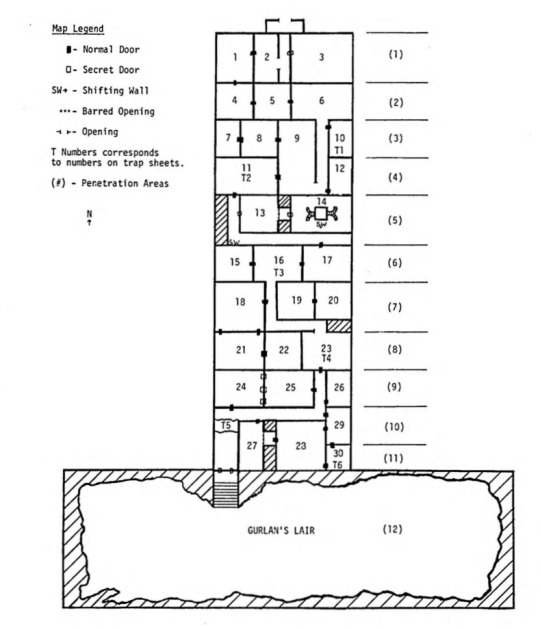
Oh. Oh that's not good. That's a very not good dungeon layout. That's a very bad dungeon layout. And the contents are, as bad. I wonder if it was considered bad at the con itself? I couldn't find a single remarkable thing in this whole dungeon. It is neither weird, nor funny, nor clever, nor interesting. It's 30 random dungeon rooms in a row, with a rare trap that is practically randomized also.
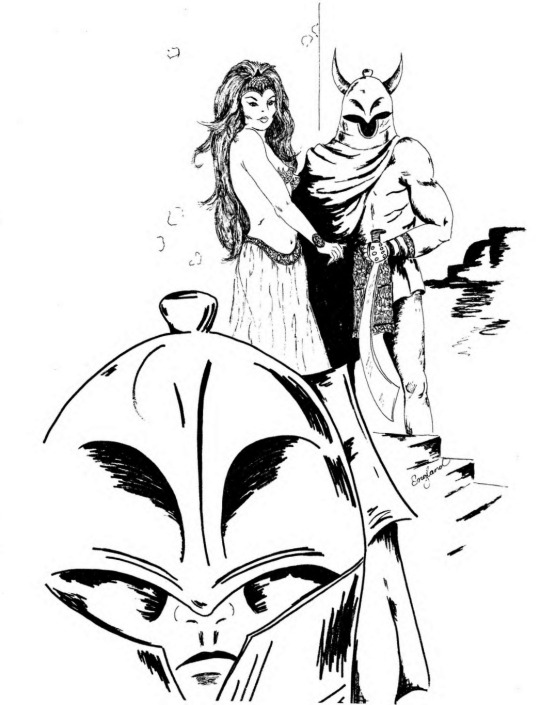
The sole joy I can find in this module is this illustration, which looks like a shitpost.
The second round of the tournament (1st round eliminates) is set in a completely different place, which is more properly called the Halls of Grsk. Almost all of this area is also just, save or suck traps and monsters. There is one trap that's kind of classic and okay -- picking up the giant ruby locks all exits, many red herrings, room starts heating up like an oven. The solution is to smash the ruby, which instantly kills the heating element. It's not amazing (how are you supposed to guess it's a ruby? It behaves like a pressure plate trap but the ruby itself is contact-activated) but it's the least bad thing in here. The portal-that-eats-you prank in particular grinds my gears, the game communicates every possible thing to say it kills you, and by blind faith you go through and is the best solution. Picking up the fake secret item instantly kills you, because fuck you. The fakeout trap's sole hint is "why are there two normal doors on the north wall?" which, it's a points-based dungeon, they're going to assume it's for extra points. Also, the whole dungeon is a massive straight line in disguise. It's a wreck.
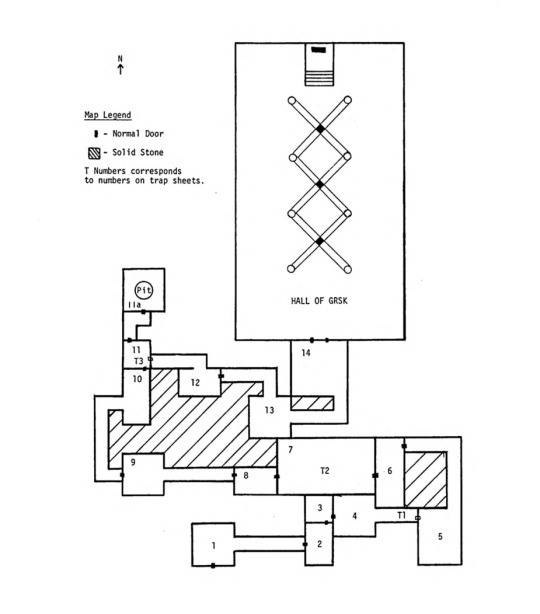
Actually, the whole scenario feels like a worse "Tomb of the Lizard King" in a lot of ways, down to the silly rhyme on the last page that gives you a critical clue about how to kill the undead baddie. In a sense it's also like Tomb of Horrors in that way, I guess, but the vibes are a lot more like Tomb of the Lizard King.
Damn it Bob, you made it boring on purpose.
Citadel of Fire (1978)
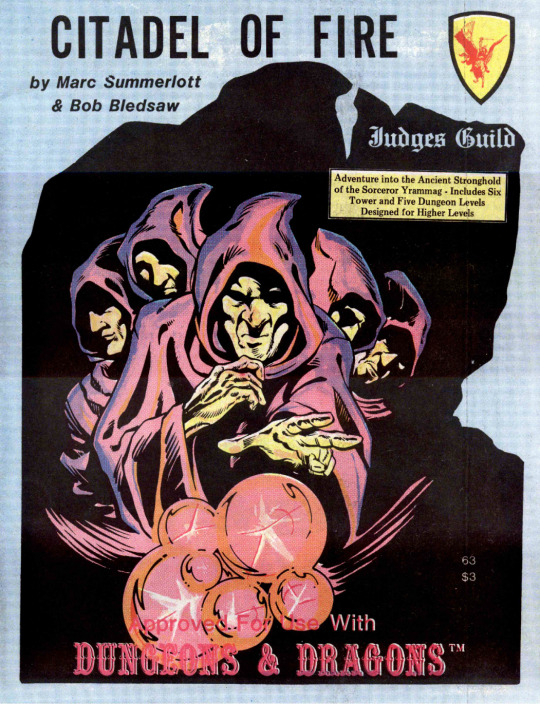
This is truly one of the dungeon covers of all time.
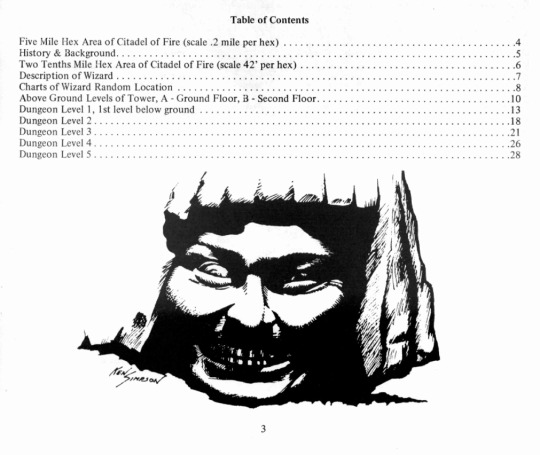
Is… is that The Golem? I hope Rabbi Loew is available. Or, maybe it's good that he's not in the module, because obviously this construct's creator is going to be evil in this module.
This is the least least imaginative of the Judge's Guild modules in this series. It is, simply a wizard's tower. If you have ever in your life read a wizard's tower module, you've read this one. The JG staples of constant slavery mentions continues with slave girls being in every single damn room of the towers. There's, not really much plot to go on either. There are wizards, the hill is good for magic, they are aligned with the goblins, go chop 'em up.
Sigh. Here's the memorable bits.

Nearly out the gate, we get one of those paragraphs that you would hope would be so obviously bad to the writers that they would second guess the decision. Why the actual hell did you stat out some 200 nearly identical goblins manually?

What is that and when do I get a bestiary entry for them? That's not a joke, the module never mentions what this is and now I want this Weresalazzle in my adventures.
The vague allusion to "Shabast", which are apparently a species of people who are intelligent clouds? But only sometimes.
A variety of pens for animals the wizards are working on, which include an Irish deer, a jackalwere, a baby lammasu, a giant slug named Skippy, some orcs, man-eating apes, an elephant, and a hydra
For…some reason there's a tavern on the 2nd floor of a dungeon. In the lightest defense of the module, at least the 2F has a surface access and no pre-programmed encounters between here and the tavern (random monsters thoooo). The owner sleeps with a new person every night, highly critical detail.

?????????????????????
OK so many rooms later there's a pyrohydra with a toothache. Mystery solved, that's why there's a magical dentist!
I hesitate to complain, but after multiple dungeons with 100k+ gold rewards, this dungeon's treasury having roughly 11,000 gold in it feels like an anticlimax. The fact that it's protected by that pyrohydra and electrified locks adds insult to injury.
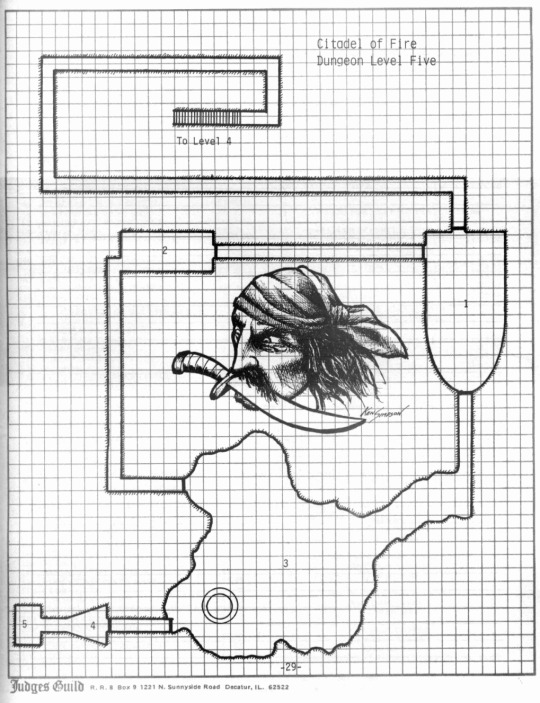
This is a joke, right? That's your final floor? Anyway, this is just The Demon Floor. There is more treasure here than upstairs, which is a little strange given that the demon serves the wizard and not the other way around.
So on the whole, deeply shit. In conclusion, Early Judge's Guild leaves a lot to be desired. Next time we will -- wait, am I free? There's no more pre-G1 modules? I get to finally do TSR shit and leave this mire?
YESSSSSSSSSSSSSSSSSSSSSSSSSSSSSSSSSSSSSSSSSSSSSSSSSSSSSSSSSSSSSSSSSSSSSSSSSSSSSSSSSSSSSSSSSSSSSSSSSSSSSSSSSSSSSSSSSSSSSSSSSSSSSSSSSSSSSSSSSSSSS (edit: I was half-right -- there was one more pre-G1 module, but it was TSR!)
7 notes
·
View notes